University Assignment: Qualitative Research Methods in Public Health
VerifiedAdded on 2022/12/23
|9
|2249
|87
Homework Assignment
AI Summary
This assignment analyzes a published research paper on the health and lifestyle of urban Australian Indigenous communities, addressing a significant social problem: health inequality within the indigenous population, characterized by lower life expectancy and higher rates of preventable diseases. The research explores the link between indigenous children's cultural perspectives and healthy lifestyles, aiming to develop targeted health interventions. The study employs a qualitative research design, using an epistemological paradigm to understand the origins and nature of the health disparities. Ethical considerations are paramount, with the researchers obtaining consent and engaging community members. The study uses purposive sampling to select participants aged 5-12 and employs focus group data collection techniques. Findings highlight the importance of cultural practices in daily life and their association with healthy lifestyle behaviors, particularly in connection to culture and self. The research suggests that effective interventions should support culture as a method of promoting health and addresses the research question by demonstrating a positive relationship between indigenous culture and healthy lifestyle activities. The research also highlights the importance of schools, community events, and family networks to improve the knowledge and understanding of healthy lifestyles among the indigenous population.
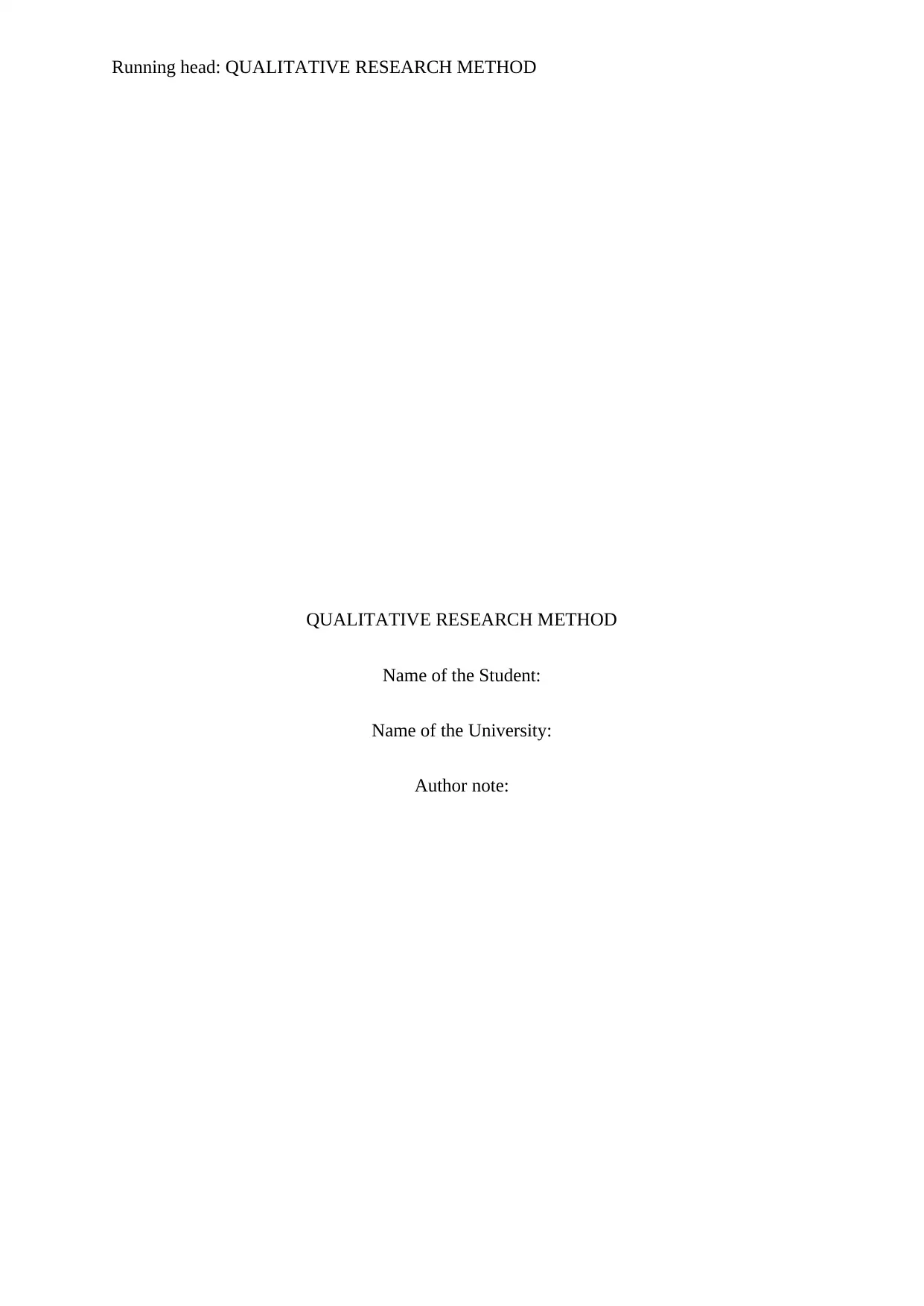
Running head: QUALITATIVE RESEARCH METHOD
QUALITATIVE RESEARCH METHOD
Name of the Student:
Name of the University:
Author note:
QUALITATIVE RESEARCH METHOD
Name of the Student:
Name of the University:
Author note:
Paraphrase This Document
Need a fresh take? Get an instant paraphrase of this document with our AI Paraphraser
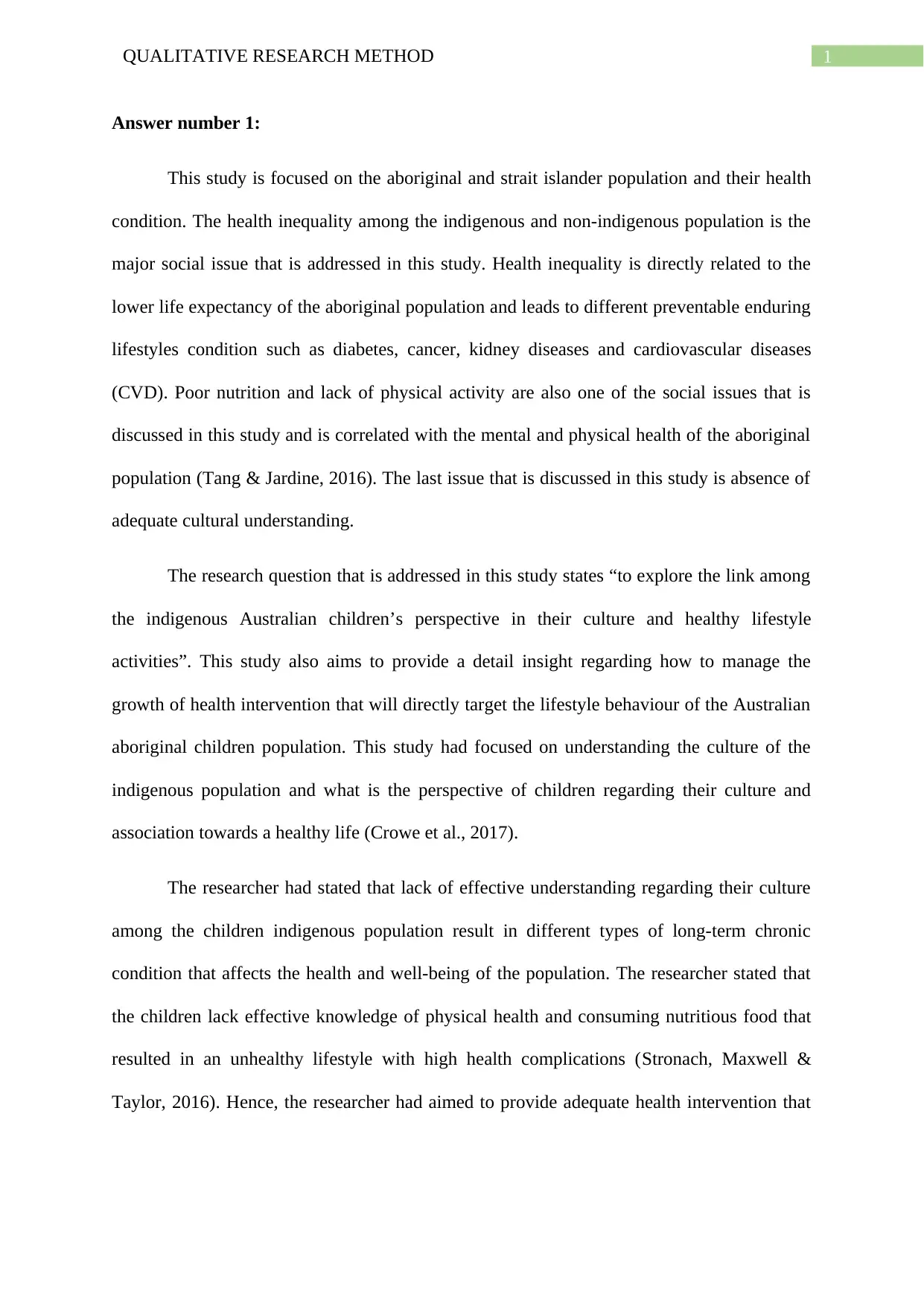
1QUALITATIVE RESEARCH METHOD
Answer number 1:
This study is focused on the aboriginal and strait islander population and their health
condition. The health inequality among the indigenous and non-indigenous population is the
major social issue that is addressed in this study. Health inequality is directly related to the
lower life expectancy of the aboriginal population and leads to different preventable enduring
lifestyles condition such as diabetes, cancer, kidney diseases and cardiovascular diseases
(CVD). Poor nutrition and lack of physical activity are also one of the social issues that is
discussed in this study and is correlated with the mental and physical health of the aboriginal
population (Tang & Jardine, 2016). The last issue that is discussed in this study is absence of
adequate cultural understanding.
The research question that is addressed in this study states “to explore the link among
the indigenous Australian children’s perspective in their culture and healthy lifestyle
activities”. This study also aims to provide a detail insight regarding how to manage the
growth of health intervention that will directly target the lifestyle behaviour of the Australian
aboriginal children population. This study had focused on understanding the culture of the
indigenous population and what is the perspective of children regarding their culture and
association towards a healthy life (Crowe et al., 2017).
The researcher had stated that lack of effective understanding regarding their culture
among the children indigenous population result in different types of long-term chronic
condition that affects the health and well-being of the population. The researcher stated that
the children lack effective knowledge of physical health and consuming nutritious food that
resulted in an unhealthy lifestyle with high health complications (Stronach, Maxwell &
Taylor, 2016). Hence, the researcher had aimed to provide adequate health intervention that
Answer number 1:
This study is focused on the aboriginal and strait islander population and their health
condition. The health inequality among the indigenous and non-indigenous population is the
major social issue that is addressed in this study. Health inequality is directly related to the
lower life expectancy of the aboriginal population and leads to different preventable enduring
lifestyles condition such as diabetes, cancer, kidney diseases and cardiovascular diseases
(CVD). Poor nutrition and lack of physical activity are also one of the social issues that is
discussed in this study and is correlated with the mental and physical health of the aboriginal
population (Tang & Jardine, 2016). The last issue that is discussed in this study is absence of
adequate cultural understanding.
The research question that is addressed in this study states “to explore the link among
the indigenous Australian children’s perspective in their culture and healthy lifestyle
activities”. This study also aims to provide a detail insight regarding how to manage the
growth of health intervention that will directly target the lifestyle behaviour of the Australian
aboriginal children population. This study had focused on understanding the culture of the
indigenous population and what is the perspective of children regarding their culture and
association towards a healthy life (Crowe et al., 2017).
The researcher had stated that lack of effective understanding regarding their culture
among the children indigenous population result in different types of long-term chronic
condition that affects the health and well-being of the population. The researcher stated that
the children lack effective knowledge of physical health and consuming nutritious food that
resulted in an unhealthy lifestyle with high health complications (Stronach, Maxwell &
Taylor, 2016). Hence, the researcher had aimed to provide adequate health intervention that
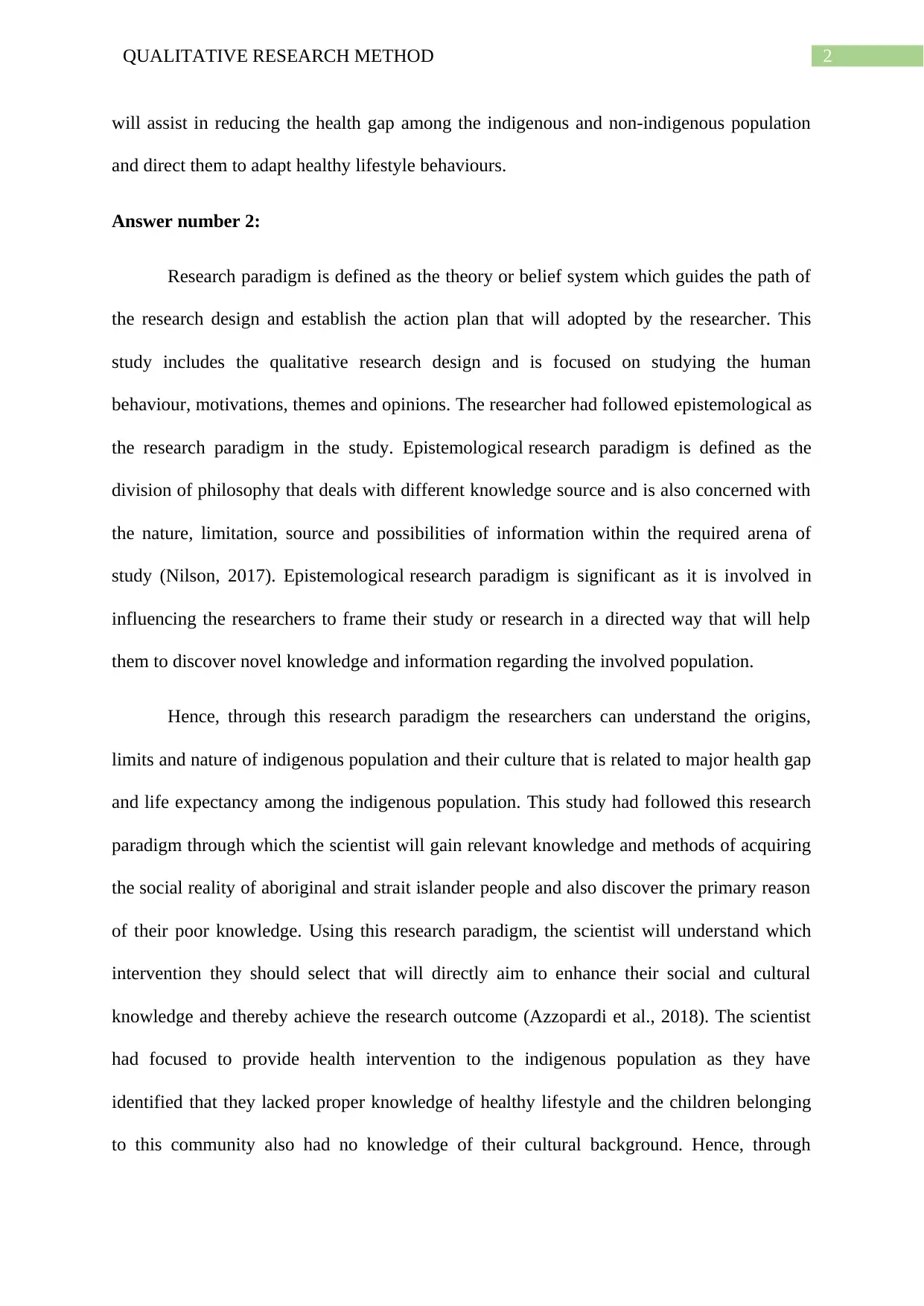
2QUALITATIVE RESEARCH METHOD
will assist in reducing the health gap among the indigenous and non-indigenous population
and direct them to adapt healthy lifestyle behaviours.
Answer number 2:
Research paradigm is defined as the theory or belief system which guides the path of
the research design and establish the action plan that will adopted by the researcher. This
study includes the qualitative research design and is focused on studying the human
behaviour, motivations, themes and opinions. The researcher had followed epistemological as
the research paradigm in the study. Epistemological research paradigm is defined as the
division of philosophy that deals with different knowledge source and is also concerned with
the nature, limitation, source and possibilities of information within the required arena of
study (Nilson, 2017). Epistemological research paradigm is significant as it is involved in
influencing the researchers to frame their study or research in a directed way that will help
them to discover novel knowledge and information regarding the involved population.
Hence, through this research paradigm the researchers can understand the origins,
limits and nature of indigenous population and their culture that is related to major health gap
and life expectancy among the indigenous population. This study had followed this research
paradigm through which the scientist will gain relevant knowledge and methods of acquiring
the social reality of aboriginal and strait islander people and also discover the primary reason
of their poor knowledge. Using this research paradigm, the scientist will understand which
intervention they should select that will directly aim to enhance their social and cultural
knowledge and thereby achieve the research outcome (Azzopardi et al., 2018). The scientist
had focused to provide health intervention to the indigenous population as they have
identified that they lacked proper knowledge of healthy lifestyle and the children belonging
to this community also had no knowledge of their cultural background. Hence, through
will assist in reducing the health gap among the indigenous and non-indigenous population
and direct them to adapt healthy lifestyle behaviours.
Answer number 2:
Research paradigm is defined as the theory or belief system which guides the path of
the research design and establish the action plan that will adopted by the researcher. This
study includes the qualitative research design and is focused on studying the human
behaviour, motivations, themes and opinions. The researcher had followed epistemological as
the research paradigm in the study. Epistemological research paradigm is defined as the
division of philosophy that deals with different knowledge source and is also concerned with
the nature, limitation, source and possibilities of information within the required arena of
study (Nilson, 2017). Epistemological research paradigm is significant as it is involved in
influencing the researchers to frame their study or research in a directed way that will help
them to discover novel knowledge and information regarding the involved population.
Hence, through this research paradigm the researchers can understand the origins,
limits and nature of indigenous population and their culture that is related to major health gap
and life expectancy among the indigenous population. This study had followed this research
paradigm through which the scientist will gain relevant knowledge and methods of acquiring
the social reality of aboriginal and strait islander people and also discover the primary reason
of their poor knowledge. Using this research paradigm, the scientist will understand which
intervention they should select that will directly aim to enhance their social and cultural
knowledge and thereby achieve the research outcome (Azzopardi et al., 2018). The scientist
had focused to provide health intervention to the indigenous population as they have
identified that they lacked proper knowledge of healthy lifestyle and the children belonging
to this community also had no knowledge of their cultural background. Hence, through
⊘ This is a preview!⊘
Do you want full access?
Subscribe today to unlock all pages.

Trusted by 1+ million students worldwide
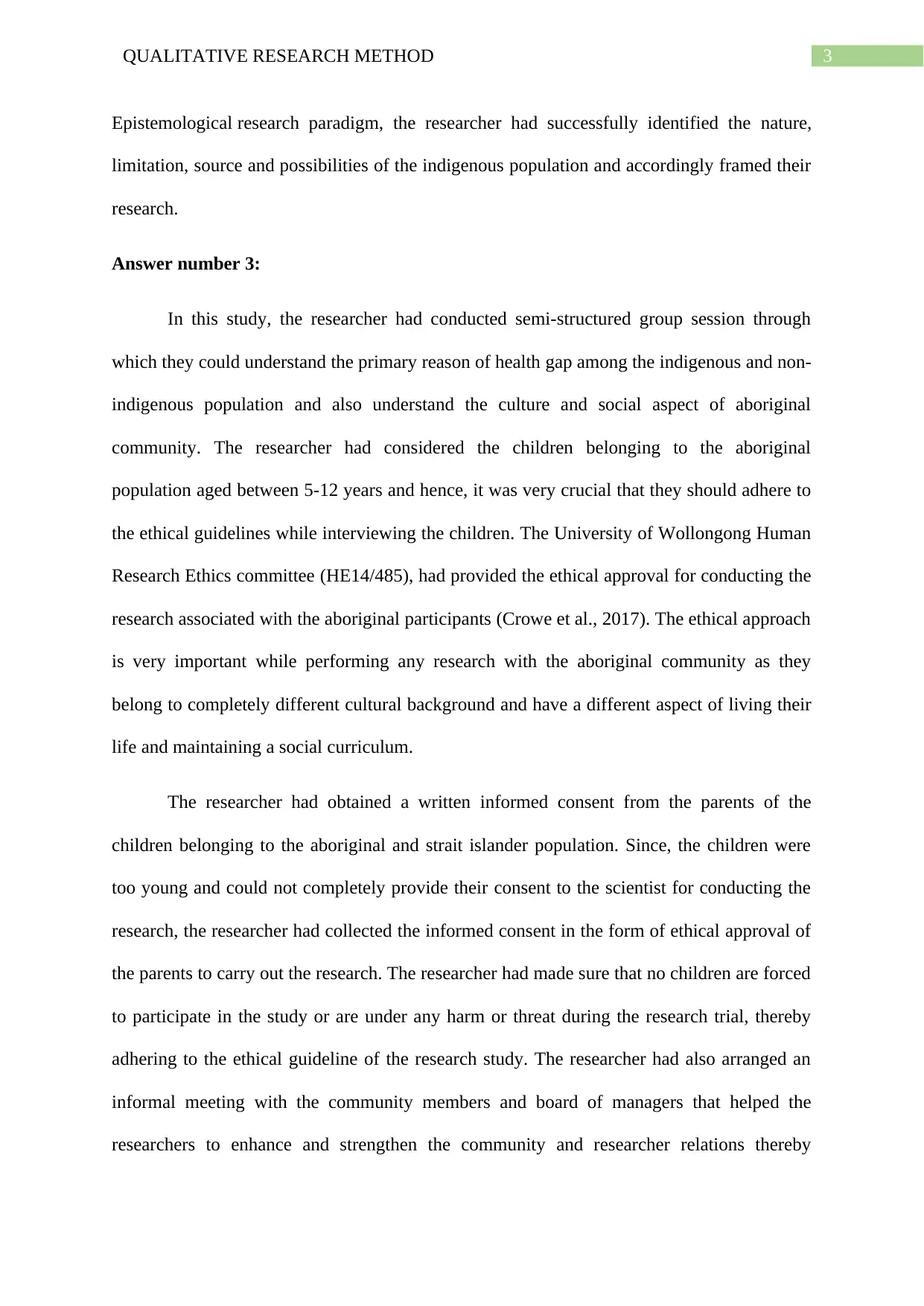
3QUALITATIVE RESEARCH METHOD
Epistemological research paradigm, the researcher had successfully identified the nature,
limitation, source and possibilities of the indigenous population and accordingly framed their
research.
Answer number 3:
In this study, the researcher had conducted semi-structured group session through
which they could understand the primary reason of health gap among the indigenous and non-
indigenous population and also understand the culture and social aspect of aboriginal
community. The researcher had considered the children belonging to the aboriginal
population aged between 5-12 years and hence, it was very crucial that they should adhere to
the ethical guidelines while interviewing the children. The University of Wollongong Human
Research Ethics committee (HE14/485), had provided the ethical approval for conducting the
research associated with the aboriginal participants (Crowe et al., 2017). The ethical approach
is very important while performing any research with the aboriginal community as they
belong to completely different cultural background and have a different aspect of living their
life and maintaining a social curriculum.
The researcher had obtained a written informed consent from the parents of the
children belonging to the aboriginal and strait islander population. Since, the children were
too young and could not completely provide their consent to the scientist for conducting the
research, the researcher had collected the informed consent in the form of ethical approval of
the parents to carry out the research. The researcher had made sure that no children are forced
to participate in the study or are under any harm or threat during the research trial, thereby
adhering to the ethical guideline of the research study. The researcher had also arranged an
informal meeting with the community members and board of managers that helped the
researchers to enhance and strengthen the community and researcher relations thereby
Epistemological research paradigm, the researcher had successfully identified the nature,
limitation, source and possibilities of the indigenous population and accordingly framed their
research.
Answer number 3:
In this study, the researcher had conducted semi-structured group session through
which they could understand the primary reason of health gap among the indigenous and non-
indigenous population and also understand the culture and social aspect of aboriginal
community. The researcher had considered the children belonging to the aboriginal
population aged between 5-12 years and hence, it was very crucial that they should adhere to
the ethical guidelines while interviewing the children. The University of Wollongong Human
Research Ethics committee (HE14/485), had provided the ethical approval for conducting the
research associated with the aboriginal participants (Crowe et al., 2017). The ethical approach
is very important while performing any research with the aboriginal community as they
belong to completely different cultural background and have a different aspect of living their
life and maintaining a social curriculum.
The researcher had obtained a written informed consent from the parents of the
children belonging to the aboriginal and strait islander population. Since, the children were
too young and could not completely provide their consent to the scientist for conducting the
research, the researcher had collected the informed consent in the form of ethical approval of
the parents to carry out the research. The researcher had made sure that no children are forced
to participate in the study or are under any harm or threat during the research trial, thereby
adhering to the ethical guideline of the research study. The researcher had also arranged an
informal meeting with the community members and board of managers that helped the
researchers to enhance and strengthen the community and researcher relations thereby
Paraphrase This Document
Need a fresh take? Get an instant paraphrase of this document with our AI Paraphraser
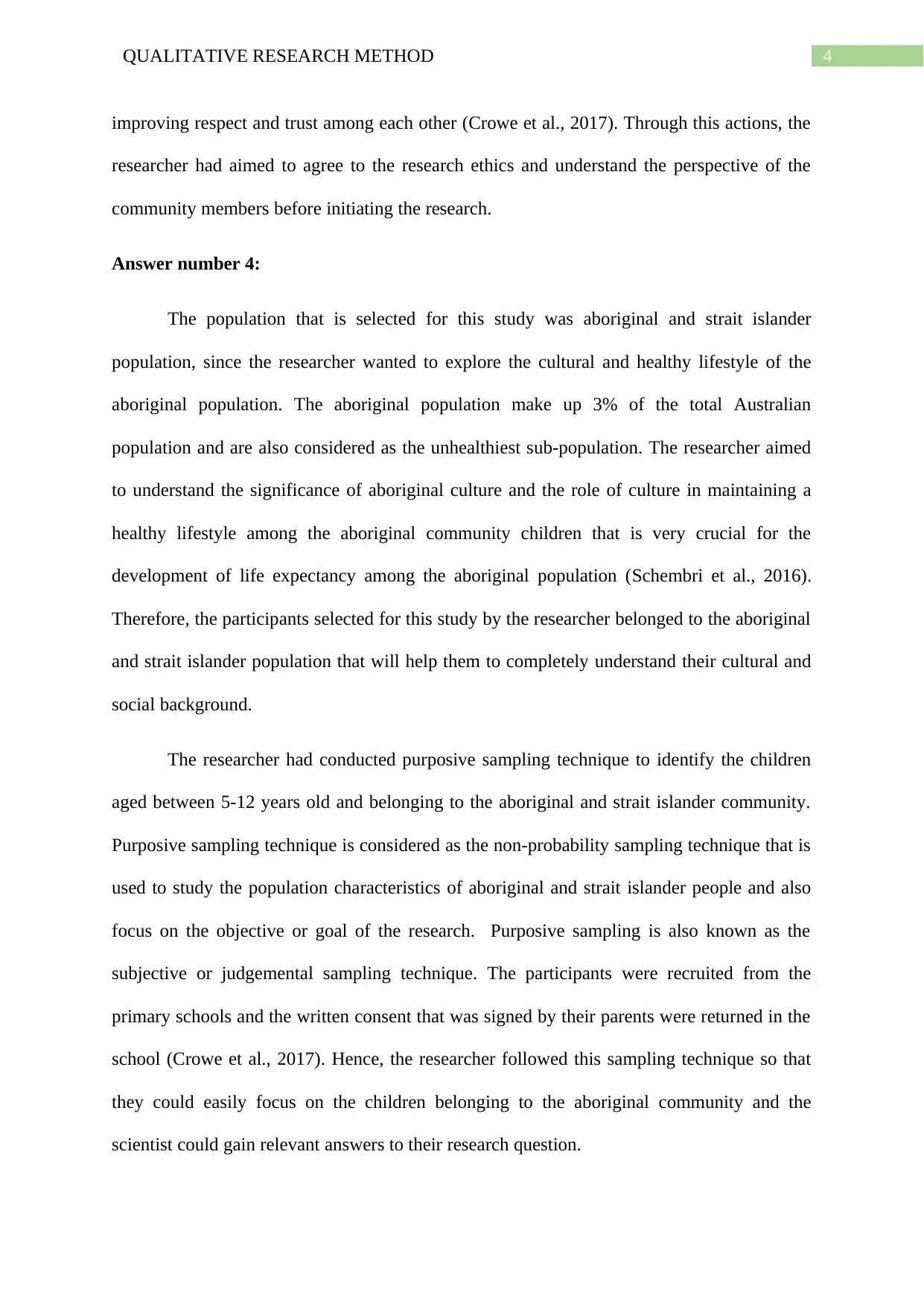
4QUALITATIVE RESEARCH METHOD
improving respect and trust among each other (Crowe et al., 2017). Through this actions, the
researcher had aimed to agree to the research ethics and understand the perspective of the
community members before initiating the research.
Answer number 4:
The population that is selected for this study was aboriginal and strait islander
population, since the researcher wanted to explore the cultural and healthy lifestyle of the
aboriginal population. The aboriginal population make up 3% of the total Australian
population and are also considered as the unhealthiest sub-population. The researcher aimed
to understand the significance of aboriginal culture and the role of culture in maintaining a
healthy lifestyle among the aboriginal community children that is very crucial for the
development of life expectancy among the aboriginal population (Schembri et al., 2016).
Therefore, the participants selected for this study by the researcher belonged to the aboriginal
and strait islander population that will help them to completely understand their cultural and
social background.
The researcher had conducted purposive sampling technique to identify the children
aged between 5-12 years old and belonging to the aboriginal and strait islander community.
Purposive sampling technique is considered as the non-probability sampling technique that is
used to study the population characteristics of aboriginal and strait islander people and also
focus on the objective or goal of the research. Purposive sampling is also known as the
subjective or judgemental sampling technique. The participants were recruited from the
primary schools and the written consent that was signed by their parents were returned in the
school (Crowe et al., 2017). Hence, the researcher followed this sampling technique so that
they could easily focus on the children belonging to the aboriginal community and the
scientist could gain relevant answers to their research question.
improving respect and trust among each other (Crowe et al., 2017). Through this actions, the
researcher had aimed to agree to the research ethics and understand the perspective of the
community members before initiating the research.
Answer number 4:
The population that is selected for this study was aboriginal and strait islander
population, since the researcher wanted to explore the cultural and healthy lifestyle of the
aboriginal population. The aboriginal population make up 3% of the total Australian
population and are also considered as the unhealthiest sub-population. The researcher aimed
to understand the significance of aboriginal culture and the role of culture in maintaining a
healthy lifestyle among the aboriginal community children that is very crucial for the
development of life expectancy among the aboriginal population (Schembri et al., 2016).
Therefore, the participants selected for this study by the researcher belonged to the aboriginal
and strait islander population that will help them to completely understand their cultural and
social background.
The researcher had conducted purposive sampling technique to identify the children
aged between 5-12 years old and belonging to the aboriginal and strait islander community.
Purposive sampling technique is considered as the non-probability sampling technique that is
used to study the population characteristics of aboriginal and strait islander people and also
focus on the objective or goal of the research. Purposive sampling is also known as the
subjective or judgemental sampling technique. The participants were recruited from the
primary schools and the written consent that was signed by their parents were returned in the
school (Crowe et al., 2017). Hence, the researcher followed this sampling technique so that
they could easily focus on the children belonging to the aboriginal community and the
scientist could gain relevant answers to their research question.
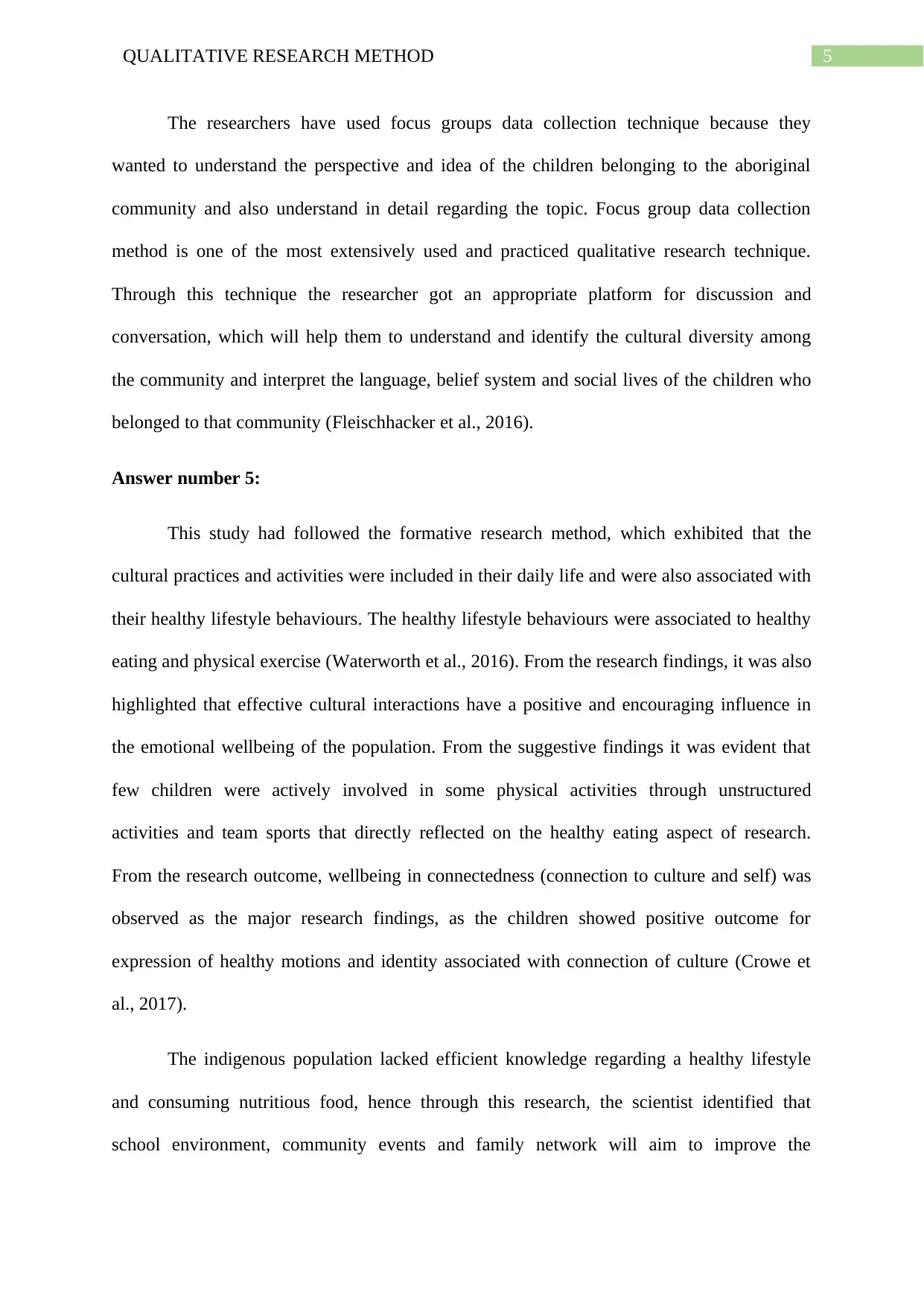
5QUALITATIVE RESEARCH METHOD
The researchers have used focus groups data collection technique because they
wanted to understand the perspective and idea of the children belonging to the aboriginal
community and also understand in detail regarding the topic. Focus group data collection
method is one of the most extensively used and practiced qualitative research technique.
Through this technique the researcher got an appropriate platform for discussion and
conversation, which will help them to understand and identify the cultural diversity among
the community and interpret the language, belief system and social lives of the children who
belonged to that community (Fleischhacker et al., 2016).
Answer number 5:
This study had followed the formative research method, which exhibited that the
cultural practices and activities were included in their daily life and were also associated with
their healthy lifestyle behaviours. The healthy lifestyle behaviours were associated to healthy
eating and physical exercise (Waterworth et al., 2016). From the research findings, it was also
highlighted that effective cultural interactions have a positive and encouraging influence in
the emotional wellbeing of the population. From the suggestive findings it was evident that
few children were actively involved in some physical activities through unstructured
activities and team sports that directly reflected on the healthy eating aspect of research.
From the research outcome, wellbeing in connectedness (connection to culture and self) was
observed as the major research findings, as the children showed positive outcome for
expression of healthy motions and identity associated with connection of culture (Crowe et
al., 2017).
The indigenous population lacked efficient knowledge regarding a healthy lifestyle
and consuming nutritious food, hence through this research, the scientist identified that
school environment, community events and family network will aim to improve the
The researchers have used focus groups data collection technique because they
wanted to understand the perspective and idea of the children belonging to the aboriginal
community and also understand in detail regarding the topic. Focus group data collection
method is one of the most extensively used and practiced qualitative research technique.
Through this technique the researcher got an appropriate platform for discussion and
conversation, which will help them to understand and identify the cultural diversity among
the community and interpret the language, belief system and social lives of the children who
belonged to that community (Fleischhacker et al., 2016).
Answer number 5:
This study had followed the formative research method, which exhibited that the
cultural practices and activities were included in their daily life and were also associated with
their healthy lifestyle behaviours. The healthy lifestyle behaviours were associated to healthy
eating and physical exercise (Waterworth et al., 2016). From the research findings, it was also
highlighted that effective cultural interactions have a positive and encouraging influence in
the emotional wellbeing of the population. From the suggestive findings it was evident that
few children were actively involved in some physical activities through unstructured
activities and team sports that directly reflected on the healthy eating aspect of research.
From the research outcome, wellbeing in connectedness (connection to culture and self) was
observed as the major research findings, as the children showed positive outcome for
expression of healthy motions and identity associated with connection of culture (Crowe et
al., 2017).
The indigenous population lacked efficient knowledge regarding a healthy lifestyle
and consuming nutritious food, hence through this research, the scientist identified that
school environment, community events and family network will aim to improve the
⊘ This is a preview!⊘
Do you want full access?
Subscribe today to unlock all pages.

Trusted by 1+ million students worldwide
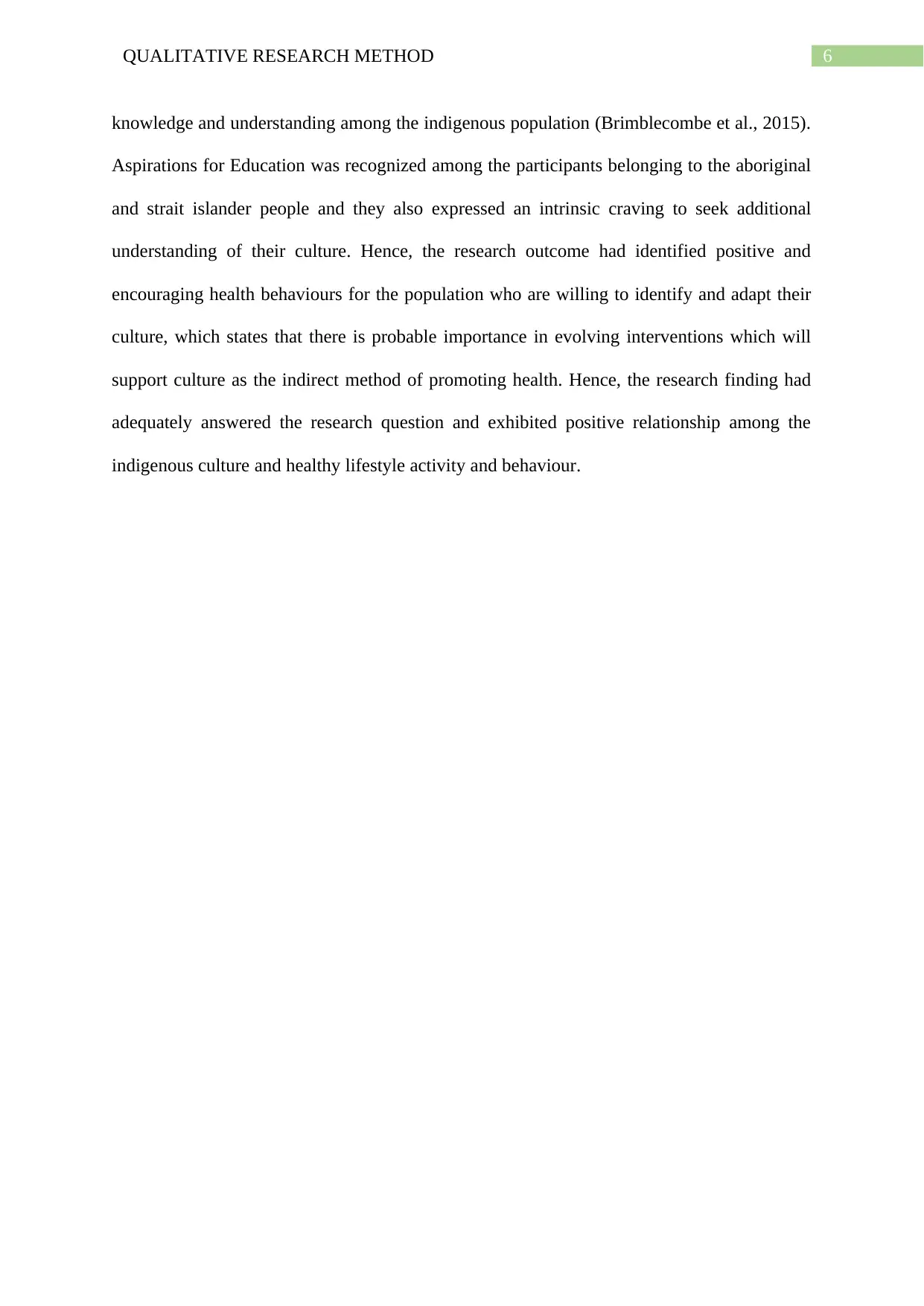
6QUALITATIVE RESEARCH METHOD
knowledge and understanding among the indigenous population (Brimblecombe et al., 2015).
Aspirations for Education was recognized among the participants belonging to the aboriginal
and strait islander people and they also expressed an intrinsic craving to seek additional
understanding of their culture. Hence, the research outcome had identified positive and
encouraging health behaviours for the population who are willing to identify and adapt their
culture, which states that there is probable importance in evolving interventions which will
support culture as the indirect method of promoting health. Hence, the research finding had
adequately answered the research question and exhibited positive relationship among the
indigenous culture and healthy lifestyle activity and behaviour.
knowledge and understanding among the indigenous population (Brimblecombe et al., 2015).
Aspirations for Education was recognized among the participants belonging to the aboriginal
and strait islander people and they also expressed an intrinsic craving to seek additional
understanding of their culture. Hence, the research outcome had identified positive and
encouraging health behaviours for the population who are willing to identify and adapt their
culture, which states that there is probable importance in evolving interventions which will
support culture as the indirect method of promoting health. Hence, the research finding had
adequately answered the research question and exhibited positive relationship among the
indigenous culture and healthy lifestyle activity and behaviour.
Paraphrase This Document
Need a fresh take? Get an instant paraphrase of this document with our AI Paraphraser
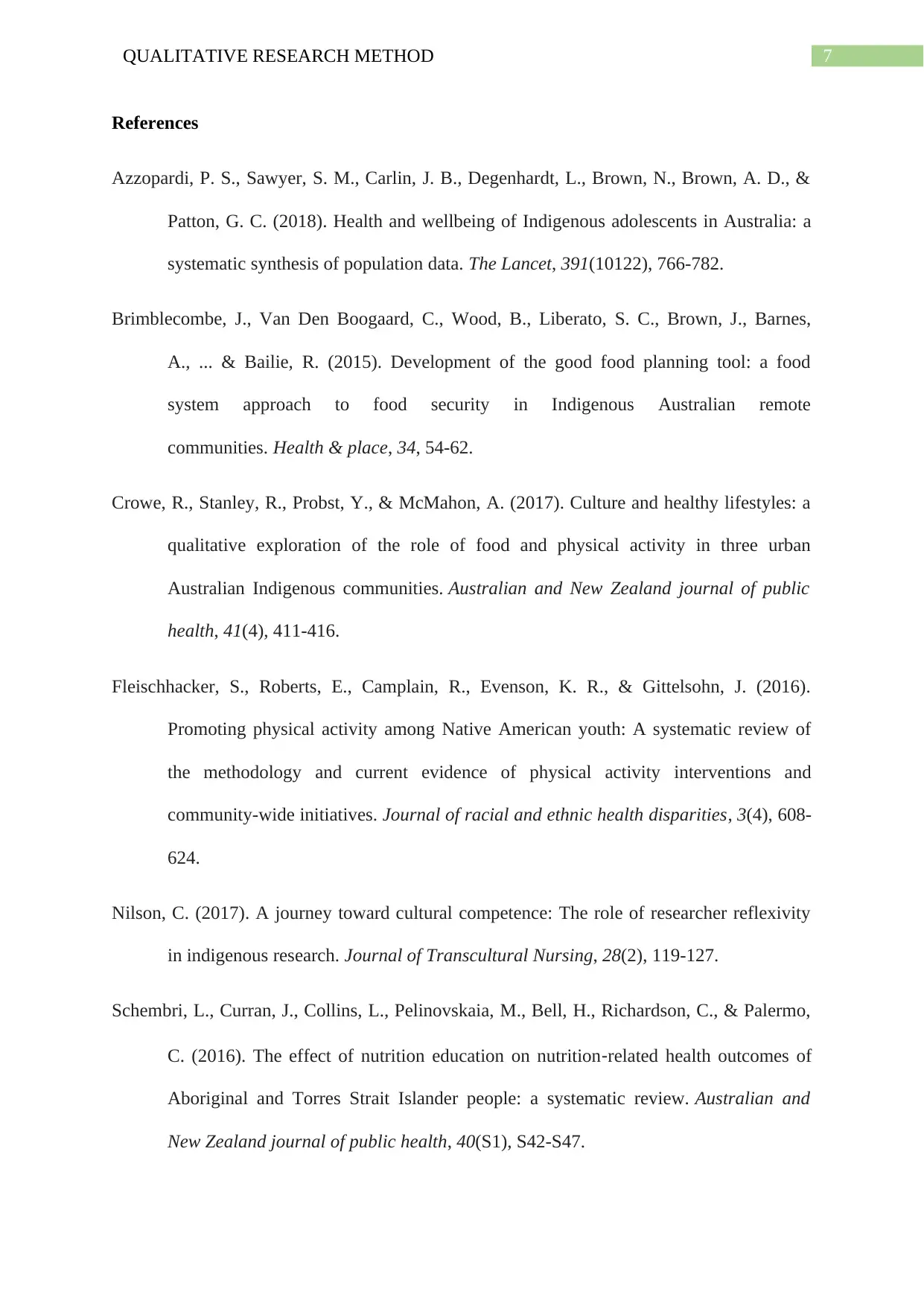
7QUALITATIVE RESEARCH METHOD
References
Azzopardi, P. S., Sawyer, S. M., Carlin, J. B., Degenhardt, L., Brown, N., Brown, A. D., &
Patton, G. C. (2018). Health and wellbeing of Indigenous adolescents in Australia: a
systematic synthesis of population data. The Lancet, 391(10122), 766-782.
Brimblecombe, J., Van Den Boogaard, C., Wood, B., Liberato, S. C., Brown, J., Barnes,
A., ... & Bailie, R. (2015). Development of the good food planning tool: a food
system approach to food security in Indigenous Australian remote
communities. Health & place, 34, 54-62.
Crowe, R., Stanley, R., Probst, Y., & McMahon, A. (2017). Culture and healthy lifestyles: a
qualitative exploration of the role of food and physical activity in three urban
Australian Indigenous communities. Australian and New Zealand journal of public
health, 41(4), 411-416.
Fleischhacker, S., Roberts, E., Camplain, R., Evenson, K. R., & Gittelsohn, J. (2016).
Promoting physical activity among Native American youth: A systematic review of
the methodology and current evidence of physical activity interventions and
community-wide initiatives. Journal of racial and ethnic health disparities, 3(4), 608-
624.
Nilson, C. (2017). A journey toward cultural competence: The role of researcher reflexivity
in indigenous research. Journal of Transcultural Nursing, 28(2), 119-127.
Schembri, L., Curran, J., Collins, L., Pelinovskaia, M., Bell, H., Richardson, C., & Palermo,
C. (2016). The effect of nutrition education on nutrition‐related health outcomes of
Aboriginal and Torres Strait Islander people: a systematic review. Australian and
New Zealand journal of public health, 40(S1), S42-S47.
References
Azzopardi, P. S., Sawyer, S. M., Carlin, J. B., Degenhardt, L., Brown, N., Brown, A. D., &
Patton, G. C. (2018). Health and wellbeing of Indigenous adolescents in Australia: a
systematic synthesis of population data. The Lancet, 391(10122), 766-782.
Brimblecombe, J., Van Den Boogaard, C., Wood, B., Liberato, S. C., Brown, J., Barnes,
A., ... & Bailie, R. (2015). Development of the good food planning tool: a food
system approach to food security in Indigenous Australian remote
communities. Health & place, 34, 54-62.
Crowe, R., Stanley, R., Probst, Y., & McMahon, A. (2017). Culture and healthy lifestyles: a
qualitative exploration of the role of food and physical activity in three urban
Australian Indigenous communities. Australian and New Zealand journal of public
health, 41(4), 411-416.
Fleischhacker, S., Roberts, E., Camplain, R., Evenson, K. R., & Gittelsohn, J. (2016).
Promoting physical activity among Native American youth: A systematic review of
the methodology and current evidence of physical activity interventions and
community-wide initiatives. Journal of racial and ethnic health disparities, 3(4), 608-
624.
Nilson, C. (2017). A journey toward cultural competence: The role of researcher reflexivity
in indigenous research. Journal of Transcultural Nursing, 28(2), 119-127.
Schembri, L., Curran, J., Collins, L., Pelinovskaia, M., Bell, H., Richardson, C., & Palermo,
C. (2016). The effect of nutrition education on nutrition‐related health outcomes of
Aboriginal and Torres Strait Islander people: a systematic review. Australian and
New Zealand journal of public health, 40(S1), S42-S47.
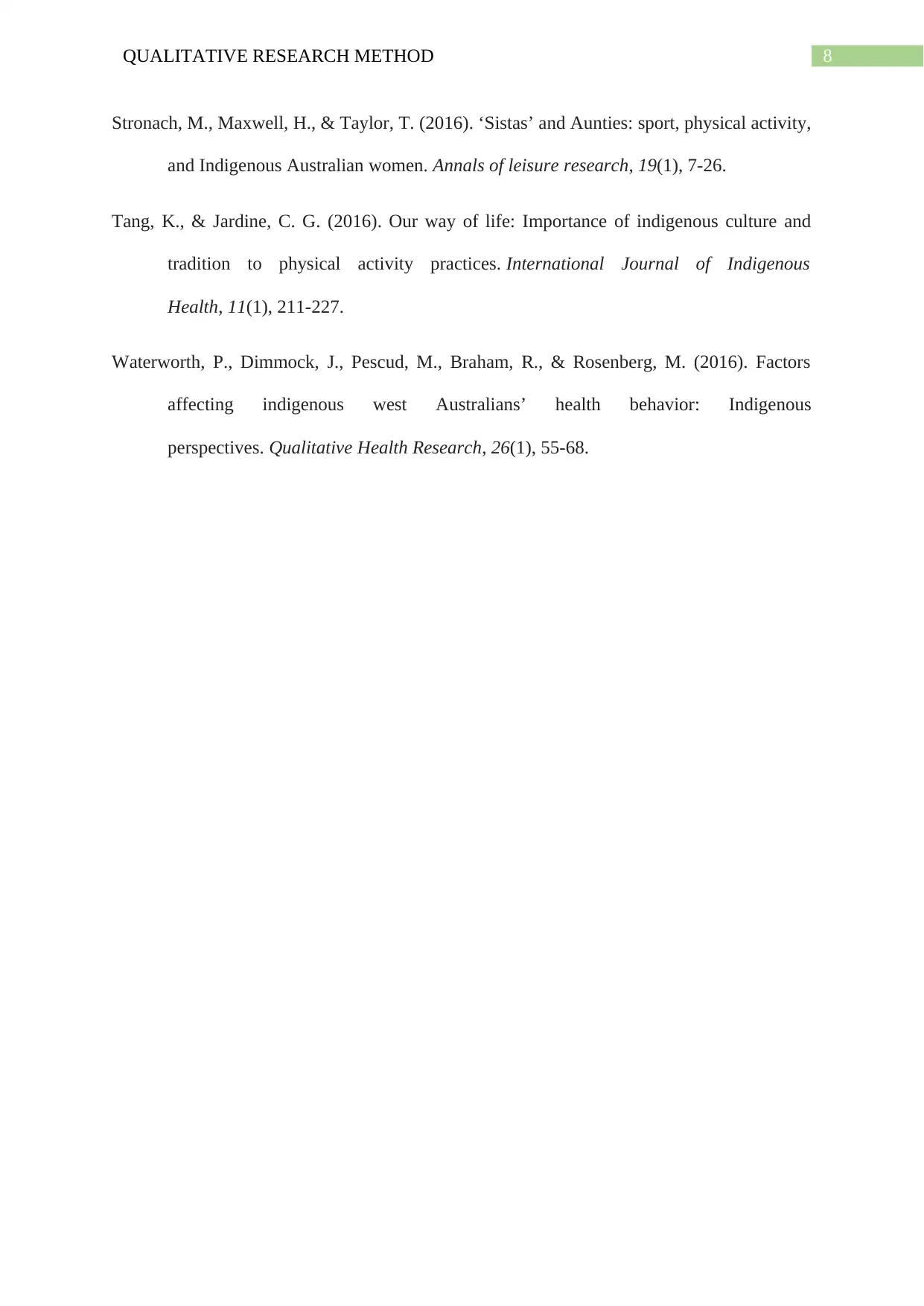
8QUALITATIVE RESEARCH METHOD
Stronach, M., Maxwell, H., & Taylor, T. (2016). ‘Sistas’ and Aunties: sport, physical activity,
and Indigenous Australian women. Annals of leisure research, 19(1), 7-26.
Tang, K., & Jardine, C. G. (2016). Our way of life: Importance of indigenous culture and
tradition to physical activity practices. International Journal of Indigenous
Health, 11(1), 211-227.
Waterworth, P., Dimmock, J., Pescud, M., Braham, R., & Rosenberg, M. (2016). Factors
affecting indigenous west Australians’ health behavior: Indigenous
perspectives. Qualitative Health Research, 26(1), 55-68.
Stronach, M., Maxwell, H., & Taylor, T. (2016). ‘Sistas’ and Aunties: sport, physical activity,
and Indigenous Australian women. Annals of leisure research, 19(1), 7-26.
Tang, K., & Jardine, C. G. (2016). Our way of life: Importance of indigenous culture and
tradition to physical activity practices. International Journal of Indigenous
Health, 11(1), 211-227.
Waterworth, P., Dimmock, J., Pescud, M., Braham, R., & Rosenberg, M. (2016). Factors
affecting indigenous west Australians’ health behavior: Indigenous
perspectives. Qualitative Health Research, 26(1), 55-68.
⊘ This is a preview!⊘
Do you want full access?
Subscribe today to unlock all pages.

Trusted by 1+ million students worldwide
1 out of 9
Related Documents
Your All-in-One AI-Powered Toolkit for Academic Success.
+13062052269
info@desklib.com
Available 24*7 on WhatsApp / Email
![[object Object]](/_next/static/media/star-bottom.7253800d.svg)
Unlock your academic potential
Copyright © 2020–2025 A2Z Services. All Rights Reserved. Developed and managed by ZUCOL.





